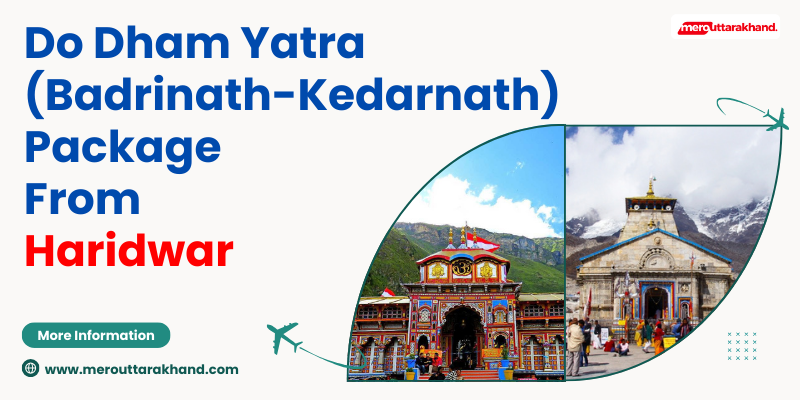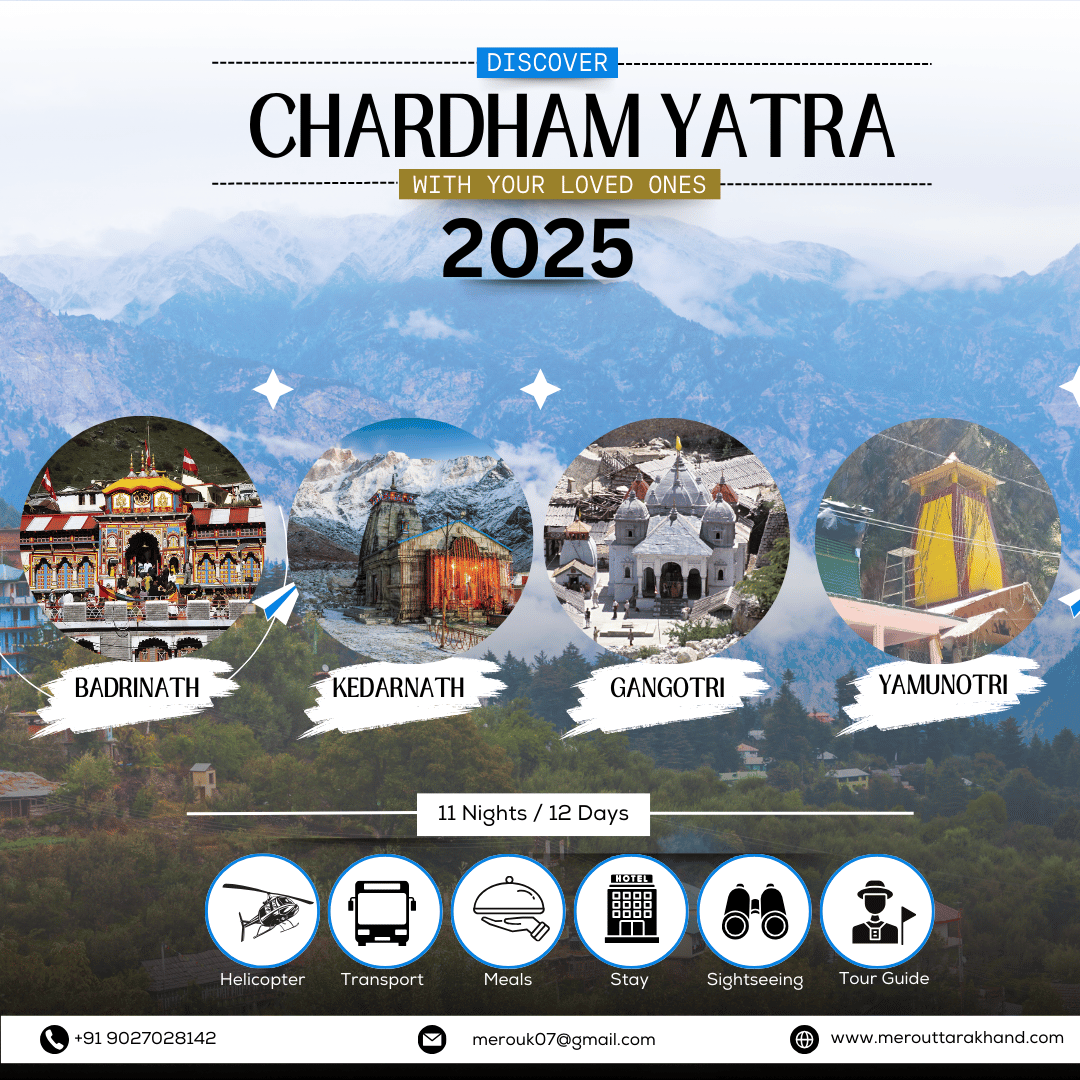Do Dham Yatra from Haridwar
Duration
6 Days
Places Cover
Haridwar - Guptkashi - Kedarnath - Sitapur - Badrinath - Joshimath - Rudraprayag - Devprayag –Rishikesh
15,000/-*
Per Person. Onwards

Overview
Discover your spiritual side by going on a Do Dham Yatra. Sacred In Hinduism, the so-called Do Dham Yatra is one of the most sought-after. Devotees visit two sacred sites in the Indian state of Uttarakhand on this journey. The Holy Himalayas, which are situated in the Garhwal region at extremely high elevations, add to the splendor of the amazing state of Uttarakhand. You can let go of all the stress that has negatively impacted your life here. The White Mountains and serene surroundings are guaranteed to pique your interest. You may be confident that your spiritual experience here will uplift your body, mind, and soul. So why wait book your Do Dham Yatra Package from Haridwar now with Merouttarakhand.
For pilgrims travelling to Delhi to begin the Do Dham Yatra from various states or perspectives, this is a comprehensive package. Passengers and pilgrims travelling from Hyderabad, Visakhapatnam, Chennai, Bangalore, and other South Indian towns may find Delhi handy because it is well-connected by rail, road, and air. Do Dham Yatra from Delhi/Haridwar is also conveniently located in Madhya Pradesh (Bhopal, Indore), Maharashtra (Mumbai, Pune, Nasik, Kolhapur), and eastern and western Uttar Pradesh.
Do Dham Yatra Package from Haridwar
Day 1: Arrive in Haridwar, go to Guptkashi, and spend the night at Guptkashi or Sitapur
As scheduled, meet our help when you arrive in Haridwar, then continue on to Guptkashi. You would pass Devprayag and Rudraprayag on your drive. Spend the night in a hotel in Sitapur or Guptkashi. We’ll rest when we get to Sitapur, Rampur, or Guptkashi. Spend the night in a hotel.
Day 2: Guptkashi to Kedarnath (Accommodation in Kedarnath)
Drive to Sonprayag-Gaurikund in the morning after breakfast. On this day, most travelers who are unable to continue their journey rest at Kedarnath Ji. The 19-kilometer journey from Sonprayag is exhausting for people who are not used with frequent walking or mountain excursions. Walking techniques that involve rest, calmness, and breathing are always beneficial when finishing this type of journey. Upon arriving, Kedarnath showered and did Darshan and Pooja at Shri Kedarnath. This is where the majority of hikers to Shri Kedarnath Ji used to stay.
Kedarnath is a magnificent site, situated in the centre of a broad plateau encircled by tall, snow-capped peaks. Adi Shankaracharya constructed the current temple in the eighth century, and it is located next to an ancient Pandava temple. Figures of numerous deities and situations from mythology adorn the assembly hall’s inner walls. A massive statue of the Nandi Bull stands watch outside the temple door.
Activities & Rituals: See the Gauri Kund, the Darshan of Kedarnath Ji Temple, Bhim Shila, and have a chance to see the Sadhus and Gurus who have been meditating in Kedarnath for a long time.
Day 3: Return to Sitapur following a 6-hour walk; overnight stay in Sitapur or Guptkashi
We will spend the night in Sitapur. Trek down to Sonpryag following morning pooja and darshan. From there, our car picks you up and drives you to a hotel for a restful night.
Day 4: Travel 220 km (07–08 hours) from Sitapur/Guptkashi to Badrinath. O/N Remain in Badrinath.
Following a typical and relaxing breakfast and wake-up, we will go to Badrinath Ji. Via Joshimath, Govindghat, Pipalkoti, and Chopta. I get to see the breathtaking Chopta and Himalayan Ranges while travelling. Along the way, we will visit three major Prayags (confluences of holy rivers): Vishnuprayag (where two rivers, the Dhauli Ganga and the Alaknanda, confluence), Karnprayag (where the rivers Pindari and Alaknanda confluence), and Nandprayag (where the rivers Nandakini and Alaknanda confluence). For compact cars, the route from Guptkashi to Chopta and subsequently to Pipalkoti is good; the road from Pipalkoti to Joshimath is superior. In the evening, we will arrive in Badrinath and spend the night at Shree Badrinath. We can take part in the evening Aarti by making a quick visit to the temple if we arrive on time. When you arrive at a temple for the Darshan of shri Badrinath Ji (Moksha Dham), you often can’t help but go.
Day 5: Travel 170 km (6 hours) from Badrinath to Joshimath to Rudraprayag.
You must finish all of your unfinished karmas and rituals on this day. Your search for salvation will be fulfilled in this Moksha Dham. Thus, this program is set up to provide you the most time possible on this land. We will be staying in Rudraprayag the following day, which is just five hours’ journey from Badrinath. Therefore, we will have roughly a half-day to finish our Darshan and ceremonies. Travel to Rudraprayag in the late morning, no later than 12:00 noon.
Activities & Rituals in Shri Badrinath: Take a holy plunge in Tapt Kund in the morning. If time permits, repeat Badri Vishal’s darshan. A significant trip to Nag Nagin Pith, one of Sarp Kal Dosh Nivaran’s favourite locations in India, A brief excursion to Charan Paduka Darshan, Ekadasi Gufa, and Hanuman Gufa, as well as Mana Village (Vyas Cave, Ganesha Cave, Keshav Prayag, and the Darshan of Sarasawati Udgam (origin)). As you return to Rudraprayag, you may see Vishnu Prayag, Nandprayag, and Karnprayag.
The holiest of the four major shrines is Badrinath, which is located on the left bank of the Alaknanda River and is surrounded by the majestic Neelkantha Peaks. It is nestled in the twin mountain ranges of Nar and Narayan. The area was formerly known as Badri van because it was covered in “badris,” or wild berries. According to legend, the ground could not bear the force of the Ganga’s descent when it was asked to come to earth to aid the suffering of people. The powerful Ganga was thus divided into twelve sacred channels. Among them was Alaknanda, which subsequently became the home of Badrinath or Lord Vishnu.
Narad Kund: The Badrinath idol was unearthed from a pool formed by a river recess close to Tapt Kund.
Brahma Kapal: It is a flat platform a few yards north of the temple and on the bank of river Alaknanda. In order to guarantee a heavenly location for deceased ancestors or manes, it is a significant location for shradh ceremonies or pind offerings. According to legend, when a pind is offered here, the manes are eternally preserved in heaven and are never to be offered again. According to legend, Brahma’s fifth head became attached on Shiva’s trident when he severed it. Last but not least, the head of Brahma fell from the trident in Badrivan with the grace of Lord Vishnu; thus, the name Brahma-Kapal (head).
Sheshnetra: It is a huge stone block with the eye of “Sheshnag” between two little, seasonal lakes. It is thought that the Sheshnag patiently awaits the lord’s rebirth at this location. The eye creation is fairly natural, and 1.5 kilometres away is a boulder that bears an impression of the fabled snake, also known as the Sheshnag’s eye.
Mana Village: The final Indian settlement before Tibet, it is inhabited by an Indo-Mongolian people. Every year on the day the temple closes, the local women present Choli to the goddess.
Bhim Pul: Across the rushing Saraswati River from Mana village is a huge rock that forms a natural bridge. It is thought to have been positioned there by Bhim, the second oldest of the five Pandava brothers, and offers a breathtaking view of water pouring down through the small opening beneath the rock.
Vyas Gufa: Ved Vyas is said to have written the Mahabharata and the pauranic comments in this rock cave, which is close to Mana Village.
Day 06: Rudraprayag- Devprayag –Rishikesh-Haridwar – (140 kilometres in 5 hours)
After breakfast in the morning, make your way to Haridwar. The fifth and final Parayag-Dev Parayag and Yoga Capital Rishikesh will be seen along the way. Drop you off at the railway station or airport for your next stop when you arrive in Haridwar.
Included in Do Dham Yatra Package from Haridwar
- Clean, tidy, and sanitary accommodations for double or triple sharing based on party size and preferences.
- Except for Kedarnath Ji, breakfast and dinner are served in hotels.
- Transportation services are included (Ex Haridwar).
- As per the program, all point-to-point sightseeing is feasible within the allotted time.
- Included are all parking, tolls, taxes, and driver allowances.
Excluded in Do Dham Yatra Package from Haridwar
- 5.0% GST (Government Service Tax)
- Any international or domestic air or rail tickets, the rest of the meals, table drinks, laundry, porters, ponies, palaki, tips, camera fees, ropeway charges, entrance charges, travel/personal life insurance, accident or health insurance, client personal expenses, or any other expenses incurred due to bad weather, road closures, landslides, etc., are all included in the price. Helicopter tickets to Kedarnath Ji and meals there will be paid for directly.
Things to Bring for Do Dham Yatra Package from Haridwar
- Valid ID Document
- Cash & Cards
- Comfy Clothing
- Snacks & Fruits
- Portable Chargers
- Basic First Aid Kit
- Camera or Smartphone
- Sunglasses & Sunscreen
How to Get There
- By Air: The nearest airport to Haridwar is the Jolly Grant Airport (DED) in Dehradun. Passengers can travel directly to Dehradun or take a connecting flight from any part of India.
- By Road: Depending upon their time schedule, tourists can travel by State Transport buses from various places that connect to Haridwar.
- By Train: The city’s railway station, Haridwar Railway Station (HW), is well-served by a number of express trains that connect it to other cities.
Conclusion
The Do Dham Yatra from Haridwar is a religious pilgrimage to two holy places, Kedarnath and Badrinath, with a mix of religious experience and nature. Haridwar is a good point to begin this pilgrimage, and several tour packages can be taken to make the journey easier. The Do Dham Yatra in Uttarakhand also involves visits to other holy sites and sightseeing during the trip, making the overall religious and cultural experience more enjoyable.
Related FAQs
Is It Safe to Book Do Dham Yatra Package from Haridwar?
Yes, it is safe to book Do Dham Yatra Package from Haridwar as merouttarakhand is safe to book adventure activities such as this and all their ground staff members are experienced with years of experience.
Are there any hidden charges in the Package?
No, there are not any secret package charges but tipping, personal spends and food spends over and above the package are not within the package.
Is Do Dham Yatra Package from Haridwar safe for those who are going for it the first time?
Yes, Do Dham Yatra Package from Haridwar is safe for fresher so whoever fulfills minimum requirements of Age Limit and Weight Limit and without any medical disorder can opt for this activity.
Are the meals parts of the package?
Breakfast and dinner with lunch only in Kedarnath are part of it. Lunch elsewhere and other meals can be included at extra costs based on the package.
Is there an age limit for the yatra?
No, there isn’t any fixed cut-off age, but older travelers and infants should be healthy enough to complete the pilgrimage.
Pre-Book
Tour Package with special perks only For You.

Char Dham Yatra by Helicopter
7 days
1,50,000 per person. Onwards

Chardham Yatra by Helicopter from Haridwar
6 Days
2,30,000 per person. Onwards

Chardham Yatra by Helicopter from Dehradun
2,30,000 per person. Onwards

Chardham Yatra by Helicopter from Delhi
2,35,000 per person. Onwards
